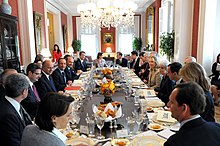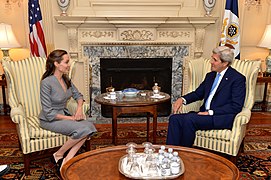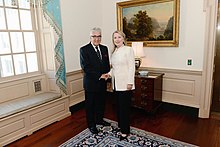
The United States Department of State (DOS), or simply the State Department, is an executive department of the U.S. federal government responsible for the country's foreign policy and relations. Equivalent to the ministry of foreign affairs of other nations, its primary duties are advising the U.S. president on international relations, administering diplomatic missions, negotiating international treaties and agreements, and representing the U.S. at the United Nations. The department is headquartered in the Harry S Truman Building, a few blocks from the White House, in the Foggy Bottom neighborhood of Washington, D.C.; "Foggy Bottom" is thus sometimes used as a metonym.
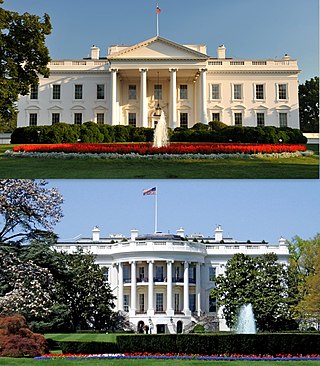
The White House is the official residence and workplace of the president of the United States. It is located at 1600 Pennsylvania Avenue NW in Washington, D.C., and has been the residence of every U.S. president since John Adams in 1800 when the national capital was moved from Philadelphia to Washington, D.C. The term "White House" is often used as metonymy for the president and his advisers.
The United States order of precedence is an advisory document maintained by the Ceremonials Division of the Office of the Chief of Protocol of the United States which lists the ceremonial order, or relative preeminence, for domestic and foreign government officials at diplomatic, ceremonial, and social events within the United States and abroad. The list is used to mitigate miscommunication and embarrassment in diplomacy, and offer a distinct and concrete spectrum of preeminence for ceremonies. Often the document is used to advise diplomatic and ceremonial event planners on seating charts and order of introduction. Former presidents, vice presidents, first ladies, second ladies, and secretaries of state and retired Supreme Court justices are also included in the list.

Malacañang Palace, officially known as Malacañan Palace, is the official residence and principal workplace of the president of the Philippines. It is located in the Manila district of San Miguel, and is commonly associated with Mendiola Street. The term Malacañang is often used as a metonym for the president, their advisers, and the Office of the President of the Philippines. The sprawling Malacañang Palace complex includes numerous mansions and office buildings designed and built largely in the bahay na bato and neoclassical styles. Among the presidents of the present Fifth Republic, only Gloria Macapagal Arroyo actually lived in the main palace as both her office and her residence, with all others residing in nearby properties that form part of the larger palace complex. The palace has been seized several times as a result of protests starting with the People Power Revolution of 1986, the 1989 coup attempt, the 2001 Manila riots, and the EDSA III riots.

A state visit is a formal visit by a head of state to a foreign country, at the invitation of the head of state of that foreign country, with the latter also acting as the official host for the duration of the state visit. Speaking for the host, it is generally called a state reception. State visits are considered to be the highest expression of friendly bilateral relations between two sovereign states, and are in general characterised by an emphasis on official public ceremonies.
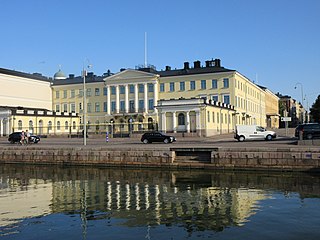
The Presidential Palace is one of the three official residences of the President of the Republic of Finland. It is situated in Helsinki, on the north side of Esplanadi, overlooking Market Square.

In the United States, the chief of protocol is an officer of the United States Department of State responsible for advising the president of the United States, the vice president of the United States, and the United States secretary of state on matters of national and international diplomatic protocol. The chief of protocol holds the rank of Ambassador and Assistant Secretary of State.

A state banquet is an official banquet hosted by the head of state in his or her official residence for another head of state, or sometimes head of government, and other guests. Usually as part of a state visit or diplomatic conference, it is held to celebrate diplomatic ties between the host and guest countries. Depending on time of the day, it may be referred to as a state dinner or state lunch. The size varies, but the numbers of diners may run into the hundreds.

The White House chief usher is the head of household staff and operations at the White House, the official residence and principal workplace of the president of the United States of America. The position is currently held by Robert B. Downing.

The Committee for the Preservation of the White House is an advisory committee charged with the preservation of the White House, the official home and principal workplace of the president of the United States. The committee is largely made up of citizens appointed by the president for their experience with historic preservation, architecture, decorative arts, and for their scholarship in these areas.
Jonathan Leo Fairbanks is an American artist and expert of American arts and antiques. Fairbanks created the American Decorative Arts and Sculpture department at the Museum of Fine Arts, Boston, and served as the Curator of the department from 1970 to 1999.

Kerala House is the official state mission of Government of Kerala at New Delhi. Each state of India has to maintain a statutory representative and state mission house in the capital to liaison with the Central Government on behalf of the state.

The Harry S Truman Building is the headquarters of the United States Department of State. It is located in Washington, D.C., and houses the office of the United States secretary of state.

The Diplomatic Reception Rooms at the U.S. Department of State constitute forty-two principal rooms and offices where the secretary of state conducts the business of modern diplomacy. Located on the seventh and eighth floors of the Harry S Truman Building in Washington, D.C., the diplomatic reception rooms contain one of the nation’s foremost museum collections of American fine and decorative arts.

Clement Ellis Conger was an American museum curator and public servant. He served as director of the U.S. Department of State Office of Fine Arts, where in that role he worked as curator of both the Diplomatic Reception Rooms and Blair House. He also served as Curator of the White House, at the pleasure of Presidents Nixon, Ford, Carter, and Reagan. Prior to working as a curator, Conger served as a Foreign Service Officer, as the Deputy Chief of Protocol of the United States and as the Assistant Secretary of the Combined Chiefs of Staff.
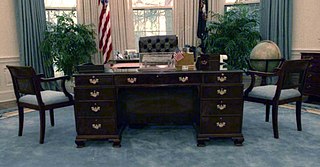
The C&O desk is one of six desks ever used in the Oval Office by a sitting President of the United States. The C&O Desk was used in the executive office by only George H. W. Bush, making it one of two Oval Office desks to be used by only one president there. Prior to its use in the Oval Office by Bush, the desk had been used elsewhere in the White House. It is the shortest-served Oval Office desk to date, having been used for one four-year term.

State and official visits to the United States are formal visits by the head of state or chief of government from one country to the United States, during which the president of the United States acts as official host of the visitor. State visits are considered to be the highest expression of friendly bilateral relations between the United States and a foreign state and are, in general, characterized by an emphasis on official public ceremonies.
Mary Mel French served as the United States Chief of Protocol, serving under President Bill Clinton. She assumed office on November 13, 1997 and left on January 20, 2001. She replaced Molly M. Raiser and was replaced by Donald Ensenat. She authored the book United States Protocol : The Guide to Official Diplomatic Etiquette.

Blair House, also known as The President's Guest House, is an official residence in Washington, D.C., the capital of the United States. The President's Guest House has been called "the world's most exclusive hotel" because it is primarily used as a state guest house to host visiting dignitaries and other guests of the president. Parts of the historic complex have been used for an official residence since the 1940s.

Edmund Stuart Bittinger, better known by Ned Bittinger, is an American portrait painter and illustrator whose work includes the official Congressional portraits of Abraham Lincoln and Lindy Boggs for the US Capitol, as well as Secretaries of State James Baker and Lawrence Eagleburger's official State Department portraits.

